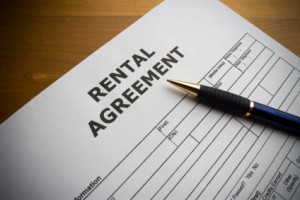Posted by Teresa on November 30, 2010 under Landlord and Tenant FAQs, Landlord Paperwork and Forms | 
 Many landlords we hear from believe that a thorough, well-written and lawyer-approved lease should contain all the rules and regulations a tenant needs to follow. And that’s partly true. But there’s a difference between the terms of a lease and the everyday policies you want your tenants to follow.
Many landlords we hear from believe that a thorough, well-written and lawyer-approved lease should contain all the rules and regulations a tenant needs to follow. And that’s partly true. But there’s a difference between the terms of a lease and the everyday policies you want your tenants to follow.
As a rule, leases are where the legalese lives: the legal description of the property, legal names of the parties involved, legal termininology, and the landlord’s legal recourse when terms are not followed. The “house rules” are generally more relaxed in language, are more flexible (i.e., they can change at any time with notice to all residents) and are simply intended to help everyone get along better and live in harmony. They are generally not legally-enforceable documents.
A signature on your list of policies or house rules is just as important as the signature on the lease. You want to be clear that your tenant understands the rules and agrees to abide by them. Review them together at the time of the lease signing, and be sure to ask if any item needs clarification.
10 Items to Include in Your Rental Property Rules
- Noise: Emphasize that consideration for other tenants is required, and that while your rental unit is well-constructed, it is not to be considered sound proof. Noises that disrupt others’ quiet enjoyment are not allowed. Include quiet hours, if desired.
- Window Treatments: Here you’ll include whether or not blinds or drapes are included with the rental unit and what care they require. If no treatments are provided, you may want to specify what color and type of coverings are allowed—and what are not allowed (like aluminum foil).
- Keys: Any key replacement fee should be included here, as well as emergency lock-out fees if a tenant forgets his or her keys after hours.
- Inclement Weather Procedures: Inform tenants of your requests during times of high winds, low temperatures, or high rain, as well as thermostat settings when the rental unit is occupied for specified lengths of time.
- Trash and Recycling: Tenants need to know what can be recycled and where it goes, along with non-recyclable trash.
- Parking: Where tenants are allowed to park, how many vehicles each unit is allowed to keep onsite, where not to park, and whether or not non-running vehicles are allowed are some of the rules you’ll want to spell out here.
- Common Areas: Are tenants allowed to leave property in common areas like hallways, sidewalks and patios? Who is responsible for clearing snow and ice from walkways? Spell these things out here.
- Storage: Indicate where tenant storage is located, how they can access it, and any limitations (flammables, vehicles, dangerous chemicals, etc).
- Guests: Include things like where guests may park their vehicles and tenants’ responsibilities for their guests.
- Bicycle Parking: As bicycle commuting becomes more popular, many tenants will want to know where they can park their bikes. If you don’t want them chained to fences or balcony railings, specify where bike parking is allowed. Better yet, create special areas for bikes that are convenient and secure for cycling tenants.
Presenting a friendly list of house rules lets all tenants know what is expected of them and their fellow tenants. After all, who (besides fraternity kids, perhaps) wants to live in a place where there are no rules?
Posted by Teresa on October 22, 2010 under Eviction, Landlord and Tenant FAQs | 
 Have you ever needed to break a lease with a tenant? We’ve heard from a few landlords who did just that, for different reasons:
Have you ever needed to break a lease with a tenant? We’ve heard from a few landlords who did just that, for different reasons:
Nancy rented out her home in Virginia when her husband was transferred to San Jose, CA. Six months later, he was laid off from his job and they returned to their hometown. Financial difficulties kept them from buying another house. Nancy and her husband wanted to move back into their home, but their tenant still had several months left on the one-year lease they signed when they moved.
Jerry rented an apartment above his business to the son of a friend. At first, everything worked out well—but soon, the tenant started paying rent a few days late, didn’t keep the apartment clean, and made way too much noise during Jerry’s business hours. He didn’t want to evict his friend’s son, but realized he made a mistake signing a one-year lease with him.
Steve’s situation was the opposite—he had a tenant who purchased a home and wanted to break the lease three months early. Steve’s first inclination was to say “no” and require the tenant to pay all three months’ rent. But the tenant had been great—never late with rent, quiet and no trouble—and he didn’t want to punish her. He was just concerned about renting the unit again.
Nancy and Jerry handled their problem with the same solution—they incentivized their tenants to voluntarily break the lease. Nancy calculated how much she and her husband were willing to offer before picking up the phone and calling the tenant. She explained the situation, offered to help the tenant find another place to live, and then asked if he would be willing to move out early. He accepted her offer of assistance and cash, and all was well.
Jerry also offered his friend’s son an incentive to move out. He had a talk with him, explained that it wasn’t working out but he didn’t want to evict him, and gave him the rest of the month (about 20 days) in free rent if the tenant agreed to move out. (And Jerry never rented to a friend or a friend’s kid again.)
Steve wanted to end his relationship with his tenant on a good note. He calculated the three months’ rent, inspected the unit and found that it was in good shape, and offered to let the tenant out of the lease in exchange for keeping the security deposit and one month’s rent. She quickly agreed, and recommended the apartment to a co-worker, who signed a lease with Steve soon after.
It is possible to break a lease with a tenant, whether it’s you or the tenant who wants it broken. Usually a little incentive does the trick—but it doesn’t hurt to be reasonable, polite and open-minded! The next time one of your tenants wants to break a lease, think about solutions rather than problems. You might be surprised to see that it can work out for both parties.
Posted by Teresa on August 9, 2010 under Landlord and Tenant FAQs, Rents and Deposits | 
 When a tenant informs you that they will not be renewing their lease, provide them with move-out instructions. Written notice of your expectations is always a good idea when it comes to dealing with tenants.
When a tenant informs you that they will not be renewing their lease, provide them with move-out instructions. Written notice of your expectations is always a good idea when it comes to dealing with tenants.
What Should Move Out Instructions Cover?
- The first item should be that a written move-out notice is required from the tenant. This helps clear up any possibility of confusion over dates and terms of the move-out.
- Ask the tenant to provide an address to which you can return the security deposit, after deducting legitimate expenses for repairs or cleaning.
- Inform the tenant you will be contacting them to conduct the move-out inspection. Let them know this is not optional: you will need the tenant to be present to initial and sign the inspection list.
- Let the tenants know that according to the terms of the lease, the unit must be returned to the same condition it was in when they moved it. If they’ve painted a different color on the walls, they need to repaint it. If they don’t clean the unit thoroughly, you can hire cleaners and deduct the fee from the tenant’s security deposit. Any damage repair costs will also be deducted from the deposit.
- If there is a fireplace in the unit, let tenants know they must have it professionally cleaned before moving.
- Tenants might not know that the last day of the lease is the day they must be out. Inform them that any extra days will be charged a prorated amount of their monthly rent. To calculate daily rent, divide the total rent by 30.
- Ask the tenant to set the thermostat at whatever temperature you prefer.
- Utilities need to be transferred to you or turned off, according to what works for you. If ther is another tenant lined up, then obviously you don’t need to turn them off. Let the tenant know to inform the utility companies, including gas, electric, cable, water and sewer, of the last day they will be in the space. Warn them not to have the utilities transferred or turned off until the end of the last day of their lease.
- Let the tenant know where to leave any extra trash and where to drop off the keys.
One thing landlords can count on is that eventually, all of their tenants will move out. Whether it’s a good thing or bad, it can be a smooth process when you’re organized and approach each move-out the same way.
Posted by Teresa on August 4, 2010 under Landlord and Tenant FAQs, Landlord Tips | 
 When rental units sit empty and you’re starting to feel desperate, it can be tempting to lower your standards and sign a lease with the first tenant who shows you the money. Experienced landlords might remember doing just that—and living to regret it.
When rental units sit empty and you’re starting to feel desperate, it can be tempting to lower your standards and sign a lease with the first tenant who shows you the money. Experienced landlords might remember doing just that—and living to regret it.
Rather than leasing to a tenant who doesn’t meet your qualifications, try to figure out why your units aren’t renting. Fix those issues and you might find the right tenant will come along sooner than you think!
10 Possible Reasons Your Rental Units are Vacant
1. The rent is too high. Check the market. Do your homework. In most markets, tenants have lots of choices. Reducing your rent is better than collecting zero rent.
2. The condition of the rental is not acceptable to good tenants. Does it look pristine or shabby? Are the railings solid or wobbly? Does the property need a coat of paint? New lighting fixtures? Ask yourself if you’d pay your rent to live there.
3. You are letting good tenants walk away. If you have a qualified applicant, don’t let them get away! Close the sale.
4. You’re not marketing the property enough. Expand your reach. Create appealing ads with great descriptions and get them out there. Put signs on the property (make sure they’re in good shape). Put arrow signs on the corners if it’s allowed.
5. The right tenants aren’t seeing your ads. Who is your ideal tenant? Where do they hang out? Whether it’s the laundromat down the street, a nearby coffee shop or Craigslist, put your ads where your best tenants will actually see them.
6. You’re not making it easy for potential tenants to reach you. Do you have a website, email and cell phone? Does your phone plan have texting? A lot of young people use texting over talking, and Gen Xers and Baby Boomers are more likely to email.
7. Your building or property manager has a bad reputation. If your current tenants are not happy with either, they are probably telling others. Ask them.
8. Your competition is giving tenants a better deal. Are there “free rent” signs on nearby properties? Find out what your competition is doing and match or beat them.
9. Your property management company (is it you?) is not doing its job. Take a hard look at how successful the rental management has been. Too many vacancies are not acceptable. And is you decide to replace them, make sure you put up “under new management” signs on your property!
10. The property looks unsafe. Visit your properties at night. How is the lighting? Are there people hanging around? Do shrubs and trees cover the windows? Fix these problems for your current tenants and potential tenants will feel safer, too.
If none of these factors apply, then you need to do some investigative work. Potential tenants won’t tell you why they decided not to sign your lease—they just go away. Follow up with the next interested, qualified tenant who disappears. Find out why they don’t want to live in your rental property. Poll your current tenants to find out what they like and dislike about living there. You need to know what’s wrong before you can fix it!
Posted by Teresa on July 2, 2010 under Landlord and Tenant FAQs | 
 Margaret is a landlord who’s trying to do her best to make all of her tenants happy—in hopes that they’ll renew their leases and save her the time and effort of finding new tenants. But she’s discovering that keeping one group of tenants happy could be putting her in legal hot water.
Margaret is a landlord who’s trying to do her best to make all of her tenants happy—in hopes that they’ll renew their leases and save her the time and effort of finding new tenants. But she’s discovering that keeping one group of tenants happy could be putting her in legal hot water.
Here’s what happened: Margaret owns a four-plex rental property, with a shared carport, individual patios, and a common back yard. There are no fences or dividers, and each tenant uses the back yard as they please. Two of her tenants have children, and two do not. All are on one-year leases.
The basic lease that all four tenants signed stipulates that children are allowed to play in the front and back yard areas of the building, and on sidewalks that lead up to the unit they live in. They are not to play in the carport.
Stacy is one of the tenants without children. She complained to Margaret that her neighbors’ kids were playing too close to her patio, and too loudly. She threatened to move at the end of her lease, which was coming up in 60 days. Stacy is an ideal tenant—never late with her rent, respecting Margaret’s time and appreciative of her efforts to keep the rental unit well-maintained. She rarely complained about anything.
Margaret wanted to appease Stacy. Besides, she agreed with her that it was unfair for the neighbors’ kids to play near her patio, disturbing Stacy’s peace and quiet. So Margaret sent letters to the two tenants with children, informing them that effective immediately, the children’s play area would be limited to their own front sidewalks and patios.
The result? The parents responded negatively, and threatened legal action against Margaret. And they had a legitimate point—their leases, clearly stipulating where the children could play, were still in place. Additionally, the lease only mentioned quiet hours from 10:00 p.m. to 7:00 a.m. So, Stacy’s noise complaint had no basis.
All of Margaret’s tenants signed the same lease. If Stacy had an issue with the rules about where kids could play, she should have dealt with it before she signed the lease. And if Margaret wants to change the rules for her long-term lease tenants, she can only do so at lease renewal time.
Landlords are also obligated to comply with the Fair Housing Act, which forbids discrimination against tenants due to familial status. So her rule about where children can and cannot play should apply to all tenants, not just children—just to be safe.
Posted by Teresa on June 4, 2010 under Landlord and Tenant FAQs, Landlord Tenant Lawsuits, Landlord Tips | 
 Take a look at these true landlord stories—and avoid repeating their mistakes. These are definite landlord don’ts!
Take a look at these true landlord stories—and avoid repeating their mistakes. These are definite landlord don’ts!
- George informed his landlord that he lost his job and can’t afford the apartment any longer, so he needed to break the lease and move. The landlord told George he’d be responsible for the rest of the rent until the lease is up— unless he’s able to rent the apartment first. George knows the landlord is having a hard time filling vacancies, so he was surprised to see the apartment on Craigslist for $500 more per month than George was paying. George knows the landlord will never rent it at that rate. He thinks the landlord is deliberately avoiding re-leasing the apartment.
Don’t be unreasonable—if you’re a landlord who is not trying to find a replacement tenant, or rejects a qualified tenant, your current tenant could have a case against you. If rents are declining, advertising a higher rent is not going to look legitimate. George knows the market. Your tenants probably do, too.
- Carrie was informed by her landlord that she’d be responsible for the cost of refinishing the hardwood floors after she moved out. Carrie didn’t think it was fair, because the floors were nearly a hundred years old, and she didn’t damage them beyond a few scratches. She thought her landlord was trying to bully Carrie into financing her new floors. Her suspicions were confirmed when she did some online sleuthing and saw that her landlord had a Twitter account—and found her tweet saying, “thanks to my tenant for beautiful new floors!”
Don’t repeat any tenant business online. If they don’t see it, their friends will. Word travels fast online!
- Sharon and Joe applied to rent an apartment. The property manager informed Sharon that because they are unmarried, each of their incomes would need to be three times the rent in order to qualify for the rental unit. Sharon thought this was unfair, so she asked the local Housing Authority to look into it. She was right—it’s illegal to require higher incomes from unmarried couples.
Don’t be ignorant of Federal and state Fair Housing Laws in any tenant interactions. Discriminating against applicants on the basis of family status, race, country of origin, religion, disability, sex, or color is illegal.
Posted by Teresa on June 2, 2010 under Landlord and Tenant FAQs, Landlord Paperwork and Forms, Tenant Screening & Background Checks | 
Leases begin and end; tenants come and go. Often, life interferes with details like legal documents (leases) and a tenant comes to you with an announcement: “I’m moving, but don’t worry—I found someone to take over my lease!”
For some landlords, this is when the worrying begins. For others, it’s not a big deal—having a new tenant without advertising and showing the rental unit is the best part about subleasing.
Subleasing is when a tenant assigns his or her lease to a third party; in effect, they are renting the unit from you, while renting it out to someone else.
To protect yourself, you should be aware of the following when considering whether or not to allow a sublease situation in your rental property:
1. Make sure the original tenant knows that a sublease itself does not release them from the original lease. If the sublease renter defaults on the terms, the original lessee is still responsible.
2. If you as landlord choose to release the tenant from the lease, then the sublease renter becomes responsible for rent and other obligations of the lease, and you become responsible for responding to the sublease renter’s needs under the lease.
3. In many cases, landlords do not release the original tenant from the lease, so the original tenant collects the rent from the sublease renter, and pays the landlord per the terms of the lease. The original tenant is also responsible for any damages to the property caused by the sublease renter.
4. You are still in control—not only can you approve or deny the applicant who wishes to sublease, but you can refuse to participate at all in a sublease situation. You then handle the tenant’s breaking of the lease agreement the way you normally do, whether it’s collecting the balance of the lease period’s rent, keeping the security deposit, or agreeing to let them out of the lease providing you find a new tenant.
5. Keep in mind that tenants don’t always inform landlords of their plans. Sometimes they move out and let their sublease renter move in—and you’re none the wiser. You are under no obligation to accept the situation, and after checking with your legal advisor, may be able to start eviction proceedings against the sublease tenant and the original tenant, too.
If your tenant asks about subleasing your rental property, check with your legal advisor first. To ensure you’re protecting your best interests, as well as your other tenants’, insist on full application procedures and tenant screening on the sublease renter.
Legal disclaimer:
The contents of this article are intended for general information purposes only, and should not be relied upon as a substitute for obtaining legal advice applicable to your situation.
Pre-screen all tenants as part of your standard application process. Background and credit checks will help ensure you rent to qualified tenants. For more landlord resources, including forms and information on tenant screening, turn to E-Renter.com.
Posted by Teresa on May 10, 2010 under Landlord and Tenant FAQs | 
 Section 8 is the widely-known term for the U.S. Government’s subsidized housing program, which allows low-income families and individuals to live in affordable and safe privately-owned rental housing. The program’s official name is “Housing Choice,” and it is the government’s major housing assistance program.
Section 8 is the widely-known term for the U.S. Government’s subsidized housing program, which allows low-income families and individuals to live in affordable and safe privately-owned rental housing. The program’s official name is “Housing Choice,” and it is the government’s major housing assistance program.
How Is Section 8 Housing Different from Public Housing?
Those who receive Housing Choice vouchers find their own apartment, townhouse, or rental home, and the U.S. Government pays a specific portion of their rent. Voucher recipients are not limited to public housing—they are free to choose any rental housing that meets their needs.
How Does Section 8 Rental Housing Work?
To be eligible for Section 8 vouchers, rental units must meet minimum health and safety standards. The local Public Housing Authority (PSA) will inspect the unit to determine whether it meets the standards, and if the rent is within the Fair Market Rent (FMA) for the geographic area and size of the rental unit.
Tenants Pay the Difference Between Benefit and Rent
The PSAA calculates the tenant’s benefit. The tenants may rent a unit exceeding their benefit; they simply pay the difference between the asking rent and the amount that is subsidized. For example, an $800 monthly rent might be eligible for $600 in Section 8 assistance. The tenants would then owe the $200 difference, payable in accordance to the lease’s agreed-upon terms and conditions.
How can I Become a Section 8 Landlord?
Landlords who wish to accept Section 8 vouchers must follow certain guidelines and procedures, and inform the local Housing Authority office of Housing and Urban Development (HUD) of their interest. Vouchers are managed at the local level, and are paid directly to the landlord.
Expectations for Both Landlords and Tenants
Once a Section 8 tenant signs a lease of at least one year, the PSA enters into a contract with the landlord, for the same duration as the lease. The tenants are expected to conform to the lease, pay their share of the rent on time, and keep the rental unit in good condition. Landlords are expected to keep the unit safe and sanitary, and maintain the standards that existed when the contract was signed, as long as he or she received housing assistance payments.
The PSA will monitor the family’s income, inspect the rental unit annually, and make sure the landlord meets his or her obligations. The PSA has the right to terminate rent payments if a landlord fails to do so.
Types of Housing Choice Vouchers:
Conversion Vouchers: These help families move to private housing from public housing that has been demolished or otherwise forced the family out.
Family Unification Vouchers: Help is provided for families to rent affordable housing in order to prevent separating children from parents.
Project Based Vouchers: These encourage rental property owners to rehab or build units in specifically to lease to low-income families.
Tenant Based Vouchers: Provided to low-income tenants to help them rent safe privately-owned housing.
HUD-VASH Vouchers: Rental assistance combined with VA case management services to help low-income homeless veterans.
Vouchers for People with Disabilities: Assists low income families with disabilities.
Welfare-to-Work Vouchers: To assist families transitioning form welfare to self-sufficiency.
Witness Relocation Vouchers: Relocation assistance for witnesses of violent crimes that occur around public, Indian, and other HUD-assisted housing.
Posted by Teresa on April 30, 2010 under Landlord and Tenant FAQs, Landlord Tips | 
 Let’s say you’re a hands-off landlord, who keeps an eye on things outside your rental units; but generally, you don’t go inside until and unless you’re called upon to repair or replace something.
Let’s say you’re a hands-off landlord, who keeps an eye on things outside your rental units; but generally, you don’t go inside until and unless you’re called upon to repair or replace something.
If you’ve ever been surprised by the condition of your rental unit after a tenant moves out, perhaps you should consider inspecting your rental properties more often. Your lease probably stipulates that you are to be given access to the property with proper notice—so before barging in on your tenants, check your local and state laws.
Here are five reasons to inspect rental properties on a regular basis:
1. To see how many people actually live there. If you’re not around to check, who’s going to prevent unscreened tenants from living in your property? You might not ever know that your tenant, the sole lessee who pays the rent every month, actually has 3 friends living in your 1-bedroom apartment. Friends staying over are one thing, but you have the last word on who is allowed to live in your rental unit.
2. To check for undisclosed pets. The Internet is full of posts by tenants who aren’t supposed to have pets and hide them when the landlord stops by; or tenants who are approved for one cat, but have four. What about the 15-pound dog you approved that’sbeen replaced with a 75-pounder?
3. To check for illegal use of your property. Your tenants could be running a business from your rental property—from day care centers to illegal meth labs—and you need to know what’s going on. After all, you are liable for your tenants conduct and activity. Don’t find out when it’s too late that illegal commerce is taking place on your property.
4. To verify proper use of plumbing and electrical systems. Again, you don’t want a fire to be your tip-off that tenants have overloaded electrical outlets. And that small drip under the sink? If nobody tells you about it, you might soon be replacing the kitchen subflooring.
5. To replace smoke alarm and CO2 alarm batteries. Smart landlords keep spare batteries in their toolkits. Replacing worn out batteries can save lives.
From plumbing leaks to illegal drug activity—you truly never know what you’ll discover when inspecting your rental units. Preventing property damage and even loss of life is worth the time and effort involved, so call your tenants and schedule an inspection today!
Posted by Teresa on April 23, 2010 under Housing Trends, Landlord and Tenant FAQs | 
 Are pets welcome in your rental properties? If so, you may have noticed more tenant applicants who are moving their pets along with their kids and furniture. Pet ownership is up in the United States—and so is the percentage of rental units that are pet-friendly.
Are pets welcome in your rental properties? If so, you may have noticed more tenant applicants who are moving their pets along with their kids and furniture. Pet ownership is up in the United States—and so is the percentage of rental units that are pet-friendly.
But one reason for more pet-owning rental applicants may be the increase in foreclosures in the US. A typical track for pet owners is to get that first dog or cat when they buy their first home. But what about after they lose their job and their home—and must return to a rental lifestyle? Many are finding their pets are not welcome at rental units that otherwise work—and often, these socialized, housebroken family pets are being abandoned in shelters.
The rental market is difficult enough right now—why not remove one barrier to filling those vacant homes and apartments that are not making you any money? If you are a landlord who doesn’t accept pets, why not reconsider that policy? Studies show that allowing pets helps fill vacancies—so it’s good for business. And if you create a solid rental pet policy, you may find that the reasons you weren’t accepting pets (noise, damages, liability) were not valid after all.
Besides, it’s bad enough for a family to lose their home, for kids to move away from their neighborhood friends, and possibly switch to a new school. But it’s even worse when the comfort and companionship of a beloved pet is taken away, as well. Pet owners who are allowed to bring these family members along to a new rental are often so grateful, they are more than willing to agree to even the strictest of pet policies.
We’ve written about pet policies before. Check out the basics, and consider allowing pets in your rentals. You might find that with a large enough pet deposit to cover possible damage, plus clear rules and appropriate consequences established up front, pets in your rental properties can work for everyone!
 Many landlords we hear from believe that a thorough, well-written and lawyer-approved lease should contain all the rules and regulations a tenant needs to follow. And that’s partly true. But there’s a difference between the terms of a lease and the everyday policies you want your tenants to follow.
Many landlords we hear from believe that a thorough, well-written and lawyer-approved lease should contain all the rules and regulations a tenant needs to follow. And that’s partly true. But there’s a difference between the terms of a lease and the everyday policies you want your tenants to follow.







